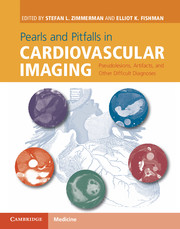 Pearls and Pitfalls in Cardiovascular Imaging
Pearls and Pitfalls in Cardiovascular Imaging from Section 4 - Coronary arteries
Published online by Cambridge University Press: 05 June 2015
Imaging description
Diseases affecting the myocardium, including myocardial infarction (MI), are generally better seen on electrocardiographically gated cardiac CT and cardiac MRI. However, signs of recent or prior MI such as myocardial hypoperfusion, lipomatous metaplasia, wall thinning, aneurysm formation, myocardial calcification, and left ventricular thrombus may be found incidentally on conventional (non-gated) CT performed for non-cardiac indications.
Although the myocardium is usually not well resolved on non-gated studies due to cardiac motion blurring, perfusion abnormalities secondary to myocardial ischemia may be occasionally detected as incidental findings (Figure 41.1). Detection of these abnormalities is dependent on acquisition during the period of optimal myocardial enhancement, which occurs in the late arterial phase. Consequently, these abnormalities may be missed on early arterial phase CT timed for the evaluation of pulmonary embolism. Even in the setting of optimal acquisition timing, care should be taken in diagnosis as false positive results due to beam hardening artifacts from adjacent bones can simulate a perfusion abnormality. In such cases, multiplanar reconstructions may help in assessing if these apparent perfusion defects match vascular territories (Figure 41.1). Subendocardial fat from lipomatous metaplasia, a marker for chronic MI that is frequently identified on non-gated CT examinations, may sometimes mimic an area of perfusion abnormality due to its low attenuation on contrast-enhanced images (Figure 41.2). However, unlike perfusion abnormalities, lipomatous metaplasia will be visible on noncontrast CT examinations. In addition, the presence of fat in the subendocardium can be confirmed by using a region of interest to measure average Hounsfield units, which should be less than zero.
Importance
Myocardial infarction is usually better seen on cardiac gated CT and cardiac MRI. However, conventional CT performed to evaluate non-cardiac causes of chest pain may have important clues suggestive of acute or chronic MI that could suggest a cardiac etiology for the patient's pain
Typical clinical scenario
Patients presenting with acute chest pain with suspicion of pulmonary embolism may get a non-gated chest CT for evaluation. CT may demonstrate presence of subendocardial perfusion abnormality in an anatomic distribution of a coronary artery, highly suggestive of MI.
To save this book to your Kindle, first ensure [email protected] is added to your Approved Personal Document E-mail List under your Personal Document Settings on the Manage Your Content and Devices page of your Amazon account. Then enter the ‘name’ part of your Kindle email address below. Find out more about saving to your Kindle.
Note you can select to save to either the @free.kindle.com or @kindle.com variations. ‘@free.kindle.com’ emails are free but can only be saved to your device when it is connected to wi-fi. ‘@kindle.com’ emails can be delivered even when you are not connected to wi-fi, but note that service fees apply.
Find out more about the Kindle Personal Document Service.
To save content items to your account, please confirm that you agree to abide by our usage policies. If this is the first time you use this feature, you will be asked to authorise Cambridge Core to connect with your account. Find out more about saving content to Dropbox.
To save content items to your account, please confirm that you agree to abide by our usage policies. If this is the first time you use this feature, you will be asked to authorise Cambridge Core to connect with your account. Find out more about saving content to Google Drive.